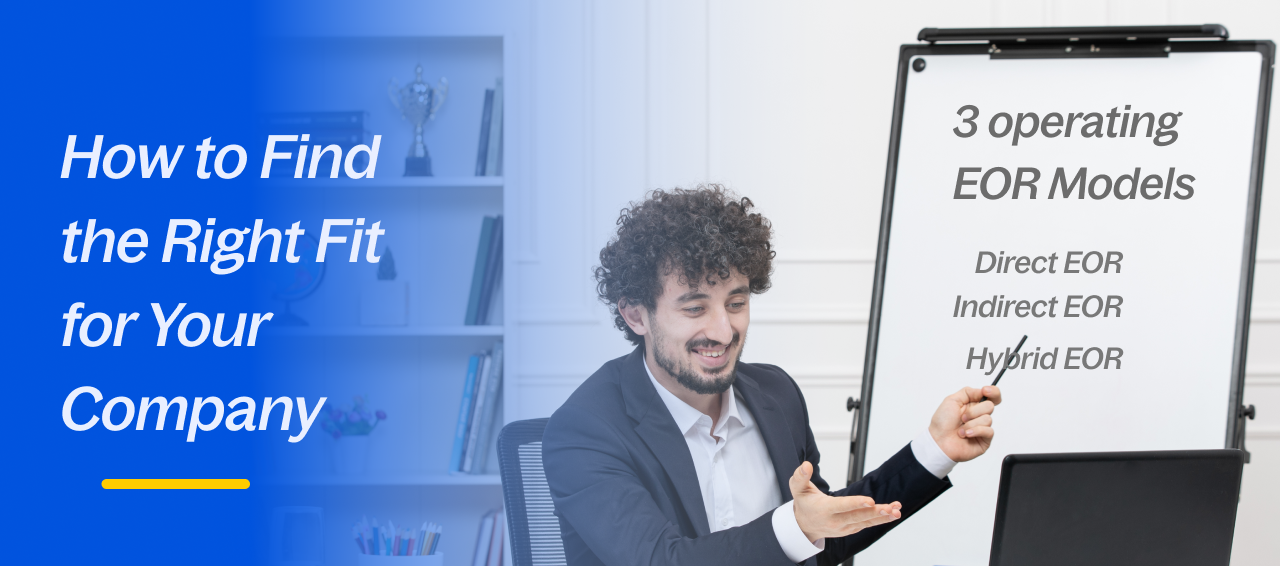Global hiring isn't optional, it's a competitive necessity. Yet most HR leaders approach international employment the way their predecessors did: build an entity, hire locally, navigate compliance solo.
That playbook now costs months you don't have and compliance risk you can't afford.The Employer of Record model inverts this.
But here's what most vendors won't tell you: not all EOR models work the same way, and choosing the wrong one can lock you into operational inefficiencies or hidden liabilities for years.
What is the Employer of Record (EOR) Service Model?
An EOR is a third-party organization that becomes the legal employer of your international hires, handling payroll, taxes, benefits, compliance, and statutory obligations across borders. You remain the operational employer, managing day-to-day work, performance, and team culture, while the EOR absorbs the legal and compliance liability.
Think of it this way: the EOR takes on the regulatory burden so you can focus on hiring strategy.
Unlike traditional hiring models, you don’t need to incorporate a local entity. Your hires are employed by the EOR in their country, meaning compliance obligations shift from you to them.
This is where confusion can arise; because not all EORs operate the same way, and the model they use determines your actual risk exposure and operational flexibility.
How the EOR Model Differs from Traditional Employment?
Traditional hiring requires you to establish a legal entity in every country where you want employees.
That's 6–12 months of legal setup, ongoing compliance complexity, and a permanent financial footprint. You're liable for every payroll error, tax misclassification, and labor violation.
With EOR, the timeline and liability structure flip:
- Setup time: 48–72 hours instead of months
- Legal liability: Transfers to the EOR (contractually defined)
- Compliance burden: EOR owns statutory filings, local tax codes, benefits mandates
- Operational flexibility: You scale hires without scaling entity complexity
The real difference is accountability architecture.
You're not avoiding compliance; you're outsourcing the entity that carries compliance responsibility. This is why choosing the right EOR model matters more than you think.
How Does the EOR Service Model Work?
Step 1: Contract & Onboarding
You provide candidate details; the EOR drafts the local employment contract, ensures compliance with regional labor laws, and prepares onboarding documentation in the local language and legal framework.
Optional services like background verification or reference checks can also be facilitated based on your organization’s policies.
Step 2: Hire Activation
The EOR officially employs the candidate. You set compensation and role; the EOR calculates local taxes, benefits contributions, and statutory deductions.
Step 3: Payroll & Compliance
Monthly payroll runs through the EOR platform. They handle tax filings, benefit contributions (PF, ESIC in India; social security in EU), and local regulatory reporting. You see transparent, country-level breakdowns.
Step 4: Ongoing Management
You manage performance and work tasks. The EOR handles employment contracts, statutory leave, terminations, and local compliance requirements. Your CSM flags edge cases.
Step 5: Scale or Transition
As you grow, you can stay with the EOR long-term or transition to your own entity. The EOR maintains full audit trails and compliance records for transition readiness.
This flow is consistent across models—the difference lies in who the EOR contracts with and how they manage your employment liability.
The Three EOR Operating Models: EOR Model Types
1. Direct EOR Model
In the Direct model, the EOR is the legal employer of your international hires. They sign employment contracts, process payroll, and assume full responsibility for compliance and statutory obligations. You remain the operational employer, managing day-to-day work and team culture.
Advantages:
- Centralized compliance control: All regulatory responsibilities are handled directly by the EOR.
- No hidden dependencies: No reliance on third-party PEOs; accountability is clear.
- Transparent, auditable employment records: Easier reporting and audits.
- Best for regulated industries: Ideal for roles in finance, healthcare, or sectors with strict labor laws.
Trade-offs:
- Higher per-employee cost: The EOR absorbs full compliance responsibility.
- Slower market entry in nascent regions: The EOR may need to establish local infrastructure before hiring.
- Some EORs may have local entities but still face compliance challenges if they’re new to the country or handle limited hiring volumes, leading to gaps in local labor law expertise.
Tip: Use Direct EOR for high-risk hires or markets with strict labor regulations to minimize compliance exposure.
2. Indirect EOR Model
In the indirect model, the EOR doesn’t directly own legal entities in every country. Instead, it partners with locally registered entities or in-country partners to employ workers on your behalf. These partners act as the legal employer for compliance and payroll purposes, while the EOR manages the overall relationship, contracts, and service delivery through them.
This is how most global EOR providers operate — leveraging a network of trusted local partners instead of maintaining entities in every jurisdiction.
Advantages:
- Lower cost: Shared compliance responsibility reduces per-employee expenses.
- Faster activation: PEO networks already exist in many emerging markets, speeding hiring.
- Leverages local expertise: Local PEOs bring deep knowledge of employment laws, benefits, and payroll practices.
Trade-offs:
- Split compliance liability: Disputes can arise between you, the EOR, and the local PEO.
- Less direct control: Companies do not decide on compliances, they can only decide on benefits
- Dependent on PEO quality: Varies by country; due diligence is essential.
Tip: Indirect EOR works best when scaling rapidly in new markets where speed and local expertise outweigh complete control.
3. Hybrid EOR Model
The Hybrid model combines Direct and Indirect approaches: Direct in strategic or heavily regulated markets (e.g., US, UK, EU, India) and Indirect in others. This allows companies to optimize compliance depth while controlling costs.
Advantages:
- Best cost-to-compliance balance: You get robust compliance where it matters most without overspending in smaller markets.
- Scales efficiently across 100+ countries: Flexibility to expand globally.
- Direct control in priority markets: Retains governance in regions with high headcount or regulatory risk.
- Flexible as your footprint evolves: Adjust strategy country by country.
Trade-offs:
- Requires sophisticated vendor management: Multiple models and providers increase complexity.
- Complex onboarding: Processes vary by country and model.
- Demands strategic partner: You need an EOR that understands your expansion roadmap.
Tip: Choose Hybrid if your global hiring footprint is diverse, with concentrated teams in priority markets and smaller teams in emerging regions.
Myths About the Indirect & Hybrid EOR Models
Myth 1: "Direct EOR is always the safest choice."
Reality: Direct EOR is the most expensive and isn't always necessary.
If you hire 2–3 people in Australia but 50 in India, a Hybrid model (Direct in India, Indirect in Australia) gives you compliance depth where it matters and cost efficiency where it doesn't.
Safety isn't binary; it's proportional to risk exposure. Gloroots' Hybrid approach lets you allocate compliance investment strategically.
Myth 2: "Indirect EOR means the EOR isn't responsible for compliance."
Reality: The EOR is contractually responsible for their local PEO partners' compliance failures.
If your Indirect PEO misclassifies a worker, you're protected—the EOR carries the liability. The difference is operational control, not responsibility. You lose some visibility into daily compliance decisions, but not protection.
Myth 3: "Hybrid models are too complicated to manage."
Reality: A well-designed Hybrid EOR abstracts complexity away from you.
One dashboard, one CSM, one invoice—but the operating model adjusts per country. The complexity is the vendor's burden, not yours. Gloroots' Hybrid model does this seamlessly: you see a uniform interface regardless of underlying model.
How to Choose the Best EOR Model for Your Business?
Ask these questions in order:
1. Where is your hiring concentrated?
If 70%+ of hires are in 2–3 countries, prioritize Direct EOR in those markets. Indirect works fine for long-tail countries.
2. What's your compliance risk tolerance?
Highly regulated industries (fintech, healthcare) demand Direct EOR. SaaS startups can tolerate Indirect in non-core markets.
3. What's your growth stage and timeline?
Early stage (0–50 employees): Hybrid or Indirect balances cost and complexity. Series B+ (50–250+ employees): Hybrid or full Direct as you consolidate headcount.
4. Are you planning an entity transition?
If you'll eventually build your own subsidiary in a country, Indirect EOR is easier to transition from (cleaner separation). Direct EOR also transitions smoothly but requires more planning.
5. How important is local hiring expertise?
If you need recruiting support, compensation benchmarking, or local talent advisory (especially in India), choose an EOR with embedded talent services. Gloroots' India Specialization includes local sourcing and GCC advisory—capabilities that matter for GCC scaling.
Decision Framework:
- Startups (0–25 employees, multi-country hiring): Start Hybrid. Cost-efficient, flexible, scales as you grow.
- Growth Stage (25–100 employees, 3–5 core countries): Shift to Direct in priority markets; keep Indirect elsewhere.
- Enterprise (100+ employees, 10+ countries): Full Direct or strategic Hybrid depending on regulatory requirements.
Summing Up
Choosing an EOR model is about matching your compliance needs to your hiring footprint and growth stage.
Direct EOR offers maximum control and liability protection but costs more. Indirect EOR reduces costs but trades some operational visibility. Hybrid gives you both, if your vendor understands your markets deeply enough to execute it seamlessly.
The real question isn't which model is best. It's which model your vendor can deliver consistently as you scale from 10 to 250 employees across continents.
A vendor who knows India's PF/ESIC complexity, EU labor law nuances, and US classification risk can architect a Hybrid model that actually works—not one that collapses under pressure.
Ready to explore which EOR model fits your expansion strategy? Start with Gloroots' EOR Services.
FAQs
What's the difference between an EOR and a PEO?
An EOR is the legal employer and carries compliance liability across 100+ countries. A PEO is usually local or regional. Gloroots operates as a global EOR and partners with local PEOs in indirect markets.
Can I transition from an EOR to my own entity later?
Yes. Gloroots keeps full employment records and contracts ready for transition, typically completed in 2–4 weeks.
How does EOR compliance protect me?
The EOR handles legal compliance, taxes, and statutory obligations. You remain responsible only for operational management.
Why choose Indirect or Hybrid over Direct EOR?
Cost and speed. Indirect is cheaper for small teams in low-risk markets. Hybrid optimizes costs and compliance—Direct where complexity is high, Indirect where hiring is minimal.
How does Gloroots’ India specialization help?
Gloroots operates Direct in India, handling full statutory compliance. This ensures accurate PF, ESIC, gratuity, and labor law adherence without guesswork.
What's the cost difference between Direct, Indirect, and Hybrid?
- Direct: ~8–12% of salary
- Indirect: ~4–7%
Hybrid: ~6–10% depending on countries Hybrid typically saves 15–25% vs. full Direct while maintaining compliance in priority markets.

.webp)




























.webp)
























.webp)


.webp)


.webp)












